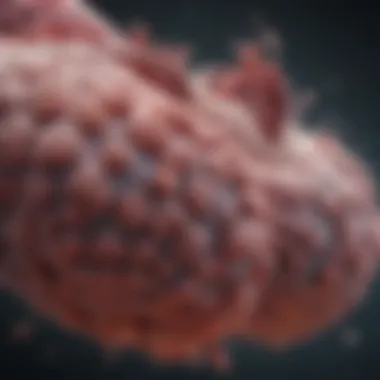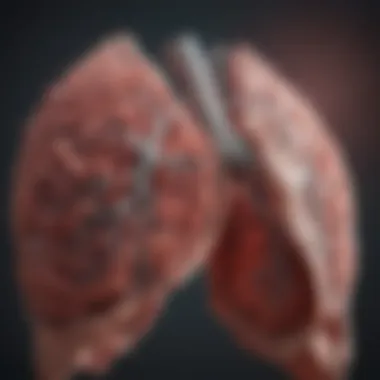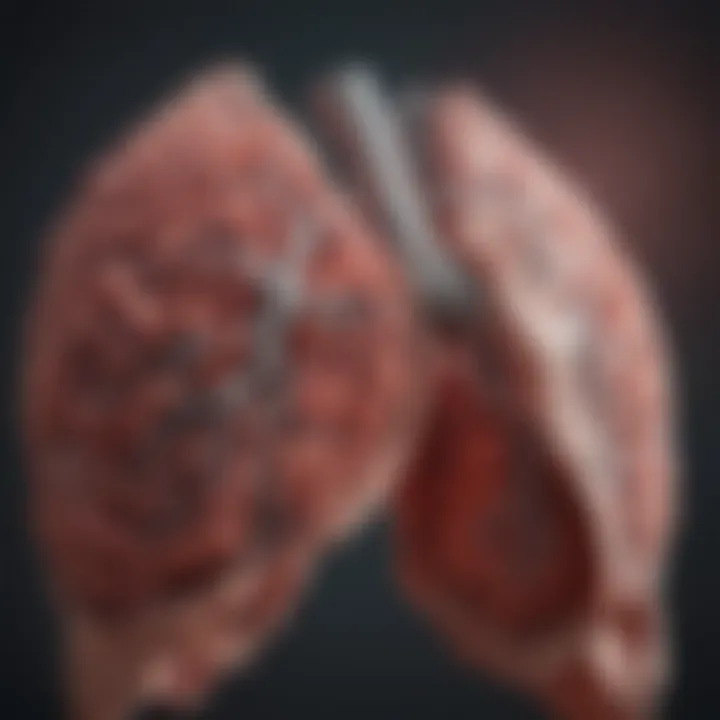Understanding Cancerous Lung Cells: A Comprehensive Exploration


Intro
Cancerous lung cells represent a critical area of study due to their significant impact on global health. Lung cancer is among the most common cancers and remains a leading cause of cancer-related deaths worldwide. Understanding the biology of cancerous lung cells entails delving into their formation, characteristics, and complexity.
The mechanisms by which lung cancers develop are multifaceted and can involve genetic mutations, environmental factors, and interactions between various cellular pathways. This reality necessitates an investigation into both specific types of lung cancers, such as small cell lung cancer and non-small cell lung cancer, and their unique characteristics. Furthermore, the continuous advancement in diagnostic methods and treatment strategies highlights the urgency of understanding these cancerous cells. This exploration serves not only as an academic pursuit but as a vital component in the fight against lung cancer.
This article will outline the biology of cancerous lung cells and offer insights into the potential future directions for research. It is essential for students, researchers, educators, and professionals to grasp the complexities involved with these cells, as this knowledge could foster improved treatments and outcomes for patients.
Preface to Cancerous Lung Cells
The study of cancerous lung cells is crucial not only to comprehend the disease itself but also to develop strategies to combat it. Lung cancer remains one of the leading causes of cancer deaths worldwide. By understanding cancerous lung cells, researchers and medical professionals can identify how these cells differ from normal lung cells, leading to more effective treatments and early detection methods.
Looking into the biology of these cells opens a pathway to targeting therapies specifically tailored to destroy cancer cells while minimizing damage to healthy tissue. This exploration helps in recognizing the behaviors that allow cancer cells to proliferate, evade the immune system, and metastasize to other organs.
Definition of Cancerous Lung Cells
Cancerous lung cells are abnormal cells that arise in the lung tissues. They exhibit uncontrolled growth, unlike normal cells that follow a regulated cycle of division and death. These cells often lose the distinct characteristics and functions that define healthy lung tissue. The process begins with changes at the genetic level, leading to mutations that disrupt normal cellular functions.
These alterations can introduce properties such as increased division rates, the ability to invade neighboring tissues, and resistance to programmed cell death, known as apoptosis. As the disease progresses, these cells accumulate further genetic mutations that can contribute to their malignancy, setting the stage for the development of lung tumor formations.
Significance of Studying Lung Cancer
Studying lung cancer is essential for several reasons. First, it provides insights into the mechanisms behind cancer cell growth and survival, which is pivotal for developing targeted therapies. Understanding the pathways that lead to lung cancer can also aid in identifying preventive measures and improving early diagnostic techniques.
Moreover, lung cancer research addresses the impact of environmental factors, such as smoking and air pollution, on lung health. Knowledge of these risk factors can inform public health initiatives aimed at reducing the incidence of lung cancer.
Additionally, research in lung cancer can contribute to advancements in personalized medicine. Tailoring therapies to individual genetic profiles has the potential to significantly improve patient outcomes. Given the complexity and diversity of lung cancers, ongoing studies are needed to unlock novel approaches and treatment options.
"Through understanding cancerous lung cells, we can unlock effective interventions that improve survival rates and enhance the quality of life for patients."
By exploring the intricacies of lung cancer, the medical community can make significant strides in combating one of the most challenging cancers today.
Cell Biology of Lung Cancer
Understanding the cell biology of lung cancer is fundamental for several reasons. It encompasses the mechanisms that underlie cancer progression and highlights crucial elements that differentiate cancerous cells from normal cells. By gaining insight into these processes, researchers can identify targets for effective treatments, making this knowledge essential in the fight against lung cancer. Moreover, it paves the way for novel therapeutic advancements and improved diagnostic techniques that could enhance patient outcomes. Understanding these biological underpinnings is a key step toward developing an integrated approach to lung cancer management.
Normal Lung Cell Structure and Function
Normal lung cells have a distinctive structure that allows them to perform essential functions. They contribute to gas exchange, secretion of mucus, and protection against pathogens. There are various types of lung cells, including epithelial cells, which line the airways, and alveolar cells, which are involved in the exchange of oxygen and carbon dioxide. Each type of cell has specific roles. For example, mucous cells help trap particles and microorganisms, while alveolar cells facilitate breathing by allowing oxygen to enter the blood.
The overall architecture of lung tissues is highly organized, enabling efficient airflow and gas exchange. The integrity of this structure is crucial; any changes can lead to dysfunction and disease. Understanding these normal processes provides a foundation for recognizing how cancerous changes disrupt these functions.
Alterations in Cancerous Lung Cells
Cancerous lung cells exhibit significant alterations compared to their normal counterparts, which plays a critical role in tumor development.
Genetic Mutations
Genetic mutations are a primary factor in the development of lung cancer. These mutations can occur due to various factors, including environmental exposures. They may affect critical genes that regulate cell growth and division, thereby allowing uncontrolled proliferation of cancer cells. A specific characteristic of genetic mutations in lung cancer is the presence of mutations in the EGFR or KRAS genes. These mutations facilitate the growth of tumors and confer unique features to the cancer cells.
A reason genetic mutations are a focal point in this article is that they not only provide insights into cancer mechanisms but also inform targeted therapies. Many treatment approaches now aim to inhibit the effects of these mutations specifically. The unique aspect of genetic mutations is that they can be used as biomarkers for diagnosis and treatment decisions, providing distinct advantages in personalizing care for lung cancer patients.
Epigenetic Changes
In addition to genetic mutations, epigenetic changes also significantly contribute to the development of lung cancer. These changes involve modifications in gene expression without altering the underlying DNA sequence. They can result from environmental factors, lifestyle choices, and other influences. A key characteristic of epigenetic changes is their potential reversibility, which presents interesting prospects for therapy.
This article includes epigenetic changes because they provide a broader understanding of cancer biology beyond just mutations. They influence how genes are expressed, thereby affecting cancer cell behavior. The unique feature of epigenetic alterations is their role in enhancing or inhibiting tumor progression, which presents both opportunities and challenges for developing effective treatments.
Epigenetic modifications may serve as potential targets for new therapies, largely due to their reversible nature, offering hope for developing interventions that can switch genes on or off in cancer cells.
Types of Lung Cancer
The categorization of lung cancer is essential for understanding the nature, treatment, and prognosis of the disease. Identifying the specific type of lung cancer can significantly influence clinical decisions. Each subtype presents unique characteristics, risk factors, and behaviors that are crucial for both diagnosis and therapeutic strategies.
Non-Small Cell Lung Cancer
Non-Small Cell Lung Cancer (NSCLC) comprises a majority of lung cancer cases, accounting for about 85% of all lung cancer diagnoses. It is significant because understanding this classification helps in determining treatment options and predicting patient outcomes. NSCLC is further divided into three primary subtypes which each have distinct biological features and implications for therapy.
Adenocarcinoma


Adenocarcinoma is the most common form of lung cancer found in non-smokers and is often located in the outer regions of the lungs. The importance of adenocarcinoma lies in its occurrence and behavior—it tends to grow slower than other lung cancer types. Its key characteristic is the production of mucus, which can complicate diagnosis since it may appear less aggressive initially.
This type is also notable for certain targeted therapies available. For example, patients with specific mutations, like those in the EGFR gene, may respond well to EGFR tyrosine kinase inhibitors. However, the disadvantage is that adenocarcinoma can often be diagnosed at a later stage, when it may have already metastasized, reducing the chances of successful treatment.
Squamous Cell Carcinoma
Squamous Cell Carcinoma (SCC) is strongly associated with smoking and typically arises in the central air passages of the lungs. Its contribution to our overall understanding of lung cancer is particularly relevant in smoking-related health discussions. The key characteristic of SCC is its propensity for a central location and a generally better prognosis in earlier stages, as it may be detectable through routine imaging.
A unique feature of SCC is the available biomarkers that aid in treatment decisions, as some patients may benefit from treatments containing immunotherapy agents. On the other hand, SCC may be more aggressive than adenocarcinoma, with a higher likelihood of spreading early, which warrants careful monitoring and intervention.
Large Cell Carcinoma
Large Cell Carcinoma is a less common, but distinctive subtype known for its variability. It can appear in any part of the lung and tends to grow rapidly. Its significance is emphasized by the challenges it poses for treatment. The key characteristic of large cell carcinoma is its heterogeneous nature, which can make it more difficult to manage effectively.
A notable feature is that it may not respond well to conventional therapies, often requiring combinations of different treatment approaches. The rapid growth rate is an advantage for researchers studying treatment options, as understanding the dynamics of this cancer can lead to better management protocols. However, the aggressive nature of this type constitutes a major disadvantage when formulating long-term care strategies.
Small Cell Lung Cancer
Small Cell Lung Cancer (SCLC) is known for its fast growth and is usually linked with large-scale smoking exposure. This type often presents as widespread by the time of diagnosis, which significantly affects treatment choices and patient outcomes. The aggressive nature and quick proliferation of SCLC require intensive treatment, such as chemotherapy and radiation. Its overall impact on patients makes it a crucial area of study in lung cancer research, guiding preventive measures and potential therapeutic solutions.
Causes of Lung Cancer
Understanding the causes of lung cancer is crucial for several reasons. It provides insights into risk factors and guides prevention strategies. By identifying how lung cancer develops, we can develop better diagnostic and treatment approaches. Knowing specific elements allows for targeted awareness programs, potentially reducing the incidence of this disease. Furthermore, it helps researchers focus on the underlying biology of lung tumors while contributing to the broader understanding of cancer itself.
Environmental Risk Factors
Smoking
Smoking is the most significant risk factor for lung cancer. It contains many harmful chemicals that damage lung cells. The tar from cigarettes coats the lungs, causing mutations over time. These mutations can lead to uncontrolled cell growth, resulting in cancer. Smoking is a widespread habit, which makes it an important subject in any discussion about lung cancer. The cumulative effect of prolonged smoking is a key characteristic, as the risk increases with the number of years and packs smoked. This article benefits from addressing smoking since it remains a leading cause of preventable disease and death worldwide.
Radon Exposure
Radon exposure is another critical environmental risk factor. Radon is a colorless, tasteless gas that can seep into homes from soil and rocks. It is a decay product of uranium and is known to accumulate in basements and confined spaces. The uniqueness of radon lies in its cumulative effect; long-term exposure increases the risk of lung cancer significantly. It is the second leading cause of lung cancer after smoking. By discussing radon, this article highlights a lesser-known risk factor that is easy to overlook yet has serious health implications.
Air Pollution
Air pollution has become a prominent concern in recent years. Exposure to airborne toxins contributes to the development of numerous health issues, including lung cancer. The presence of particulate matter, nitrogen oxides, and various chemicals in the air can lead to mutations. High levels of air pollution increase the risk of lung cancer for individuals living in urban areas. Here, the article emphasizes the importance of understanding environmental impacts on health. Additionally, while it may not be as well-known as smoking, detailing air pollution's role in lung cancer raises awareness about public health strategies and legislation to improve air quality.
Genetic Predisposition
Genetic predisposition plays a vital role in the development of lung cancer. Certain genes are responsible for regulating cell growth and repair. If these genes are mutated or dysfunctional, the body's ability to control cell proliferation is compromised. Understanding how genetics interacts with environmental factors is important for identifying individuals at risk. This knowledge can aid in early screening and tailored treatment plans. Genetic testing, however, raises many ethical questions, including privacy and accessibility that require careful consideration as research in this area progresses.
Diagnostic Approaches
Diagnostic approaches are fundamental to understanding and managing lung cancer. They allow for accurate identification and staging of the disease, which is essential for developing effective treatment plans. Proper diagnostic techniques can impact patient outcomes significantly, making this topic critical for anyone studying lung cancer.
Imaging Techniques
CT Scans
CT scans are a key diagnostic tool for lung cancer. They provide detailed cross-sectional images of the lungs, allowing doctors to see the size, shape, and position of tumors. The primary characteristic of CT scans is their ability to produce high-resolution images of internal structures, making them highly valuable in early detection of lung cancer.
A unique feature of CT scans is their speed and relatively lower cost compared to some other imaging modalities. However, one disadvantage is the exposure to radiation, which may raise concerns for patients. Despite this, CT scans are widely used because they can identify lung cancer at an earlier stage, improving treatment options and chances of survival.
MRI
MRI is another important imaging technique used to assist in lung cancer diagnosis. Unlike CT scans, MRI uses strong magnetic fields and radio waves to generate images of organs and tissues. One key characteristic of MRI is its ability to provide excellent contrast images between different types of soft tissue, making it useful for assessing the extent of lung cancer.
A unique feature of MRI is its lack of ionizing radiation, which is appealing for patients and doctors alike. However, MRI does come with some drawbacks, such as longer scan times and higher costs compared to CT scans. Overall, MRI has its place in the lung cancer diagnostic pathway, especially for assessing brain metastases or involving adjacent structures.
PET Scans
PET scans play a crucial role in lung cancer diagnostics by showing the metabolic activity of cells. This technique is particularly helpful in distinguishing between benign and malignant lesions in the lungs. The key characteristic of PET scans is their ability to detect changes in cellular activity, which can indicate cancerous growth even before structural changes appear.
A unique feature of PET scans is their capacity to combine with CT scans to provide both functional and anatomical information, greatly enhancing overall diagnostic capabilities. However, PET scans can be more expensive and often require the use of a tracer, which may not be available everywhere. Nevertheless, their ability to inform treatment decisions makes PET scans a valuable tool in the lung cancer diagnostic arsenal.
Biopsy Procedures
Biopsy procedures are critical for confirming the diagnosis of lung cancer. They involve obtaining a tissue sample from a suspicious area to determine if cancer is present. The main advantage of biopsy is the definitive confirmation of the disease, which guides further treatment.


Needle Biopsy
Needle biopsy is a minimally invasive procedure often used when imaging techniques suggest the presence of lung cancer. The primary characteristic of needle biopsy is its ability to sample tissue with minimal risk and discomfort to the patient. This procedure is usually performed with ultrasound or CT guidance, ensuring accurate targeting of the lesion.
A notable advantage of needle biopsy is that it can often be done on an outpatient basis, leading to rapid recovery. However, one disadvantage is that there can be a risk of complications such as pneumothorax, especially if the needle is placed incorrectly.
Surgical Biopsy
Surgical biopsy is a more invasive procedure that may be necessary when needle biopsy is not conclusive or when a larger tissue sample is needed. The key characteristic of surgical biopsy is that it allows for direct visualization and removal of tissue from the lung. This can provide comprehensive insight into tumor characteristics and help determine appropriate treatment.
While surgical biopsy can yield a larger sample, it comes with increased risks, including longer recovery times and potential complications such as infection. Nevertheless, when warranted, surgical biopsy plays a crucial role in confirming lung cancer diagnoses and informing treatment strategy.
The selection of diagnostic approaches is essential for effective lung cancer management. Accurate and timely diagnosis can significantly influence treatment pathways and overall patient outcomes.
Pathophysiology of Lung Cancer
Understanding the pathophysiology of lung cancer is crucial for several reasons. This section highlights the underlying biological mechanisms that facilitate cancer development in lung tissues. Pathophysiology allows researchers and clinicians to comprehend how cancerous cells interact with their environment, propagate, and eventually lead to disease progression. Recognizing these processes can improve diagnostic methods, refine treatment strategies, and potentially lead to innovative therapeutic approaches.
Tumor Microenvironment
The tumor microenvironment plays a significant role in lung cancer's progression. This environment is composed of various non-cancerous cells, including immune cells, fibroblasts, and endothelial cells, along with the extracellular matrix. These elements can contribute to tumor growth and metastasis.
- Cellular Interactions: Cancer cells often manipulate the surrounding healthy cells. They can signal to immune cells, evading detection while encouraging a pro-tumorigenic environment.
- Angiogenesis: This process refers to the formation of new blood vessels. Lung tumors frequently stimulate angiogenesis to ensure an adequate supply of oxygen and nutrients. Vascular endothelial growth factor (VEGF) is a key player in this process.
- Inflammation: Chronic inflammation in the lung tissue can enhance the risk of genetic mutations. This inflammation may come from environmental irritants, such as tobacco smoke or air pollution, thereby creating a permissive environment for cancerous changes.
The tumor microenvironment not only supports cancerous growth but also impacts how tumors respond to therapies. Understanding these interactions can lead to targeted therapies that disrupt the supportive microenvironment.
Metastasis of Lung Cancer
Metastasis is a hallmark of advanced lung cancer, where cancer cells spread from the primary tumor to other body parts. The process involves several stages:
- Invasion: Cancer cells first invade neighboring lung tissues. They can break down the cellular matrix and gain access to surrounding tissues.
- Intravasation: After invading neighboring tissues, cancer cells enter the bloodstream or lymphatic system.
- Circulation: Once in the bloodstream, cancer cells often interact with platelets and immune cells, which can protect them from immune reactions.
- Extravasation: At distant sites, cancer cells exit the bloodstream and invade new tissues.
- Colonization: Finally, these cells establish secondary tumors, often in areas like the brain, liver, or bones.
The metastatic process in lung cancer is complex and involves numerous biological factors. Research into this process aims at finding ways to halt or slow down metastasis and improve patient outcomes. Understanding the mechanisms driving lung cancer metastasis leads to more effective treatment options and enhances the overall management of this devastating disease.
The pathophysiology of lung cancer is not just about understanding the disease but also about finding the right avenues for intervention.
By exploring both the tumor microenvironment and metastasis, we can appreciate the challenges lung cancer presents and the potential for groundbreaking research and therapeutic strategies.
Treatment Options
Treatment options for lung cancer are a critical area of focus in this article. Exploring these options presents a clearer understanding of how various therapies interact with cancerous lung cells. Different strategies could be employed depending on the cancer's stage and type. Understanding treatment options not only helps in managing the disease but also guides future research for improvements. Patients must consider the benefits and limitations of these therapies, making informed decisions that optimize their outcomes.
Surgical Interventions
Surgical interventions serve as a primary treatment for many lung cancers. The primary goal of surgery is to remove the tumor and some surrounding healthy tissue to minimize the chances of recurrence. Surgical options include lobectomy, which involves removing a lobe of the lung, and pneumonectomy, which removes an entire lung. In some cases, wedge resection is performed, which involves taking out a small, wedge-shaped section of lung tissue.
While surgery can be effective, it is not suitable for all patients. Factors such as tumor size, location, and overall health play a significant role in determining candidacy for surgical procedures. Post-surgery care is equally essential to manage complications and support recovery.
Chemotherapy and Radiotherapy
Chemotherapy and radiotherapy are essential components in treating lung cancer. Chemotherapy uses drugs to kill cancer cells or slow their growth. It can be administered before surgery, as neoadjuvant therapy, to shrink tumors or following surgery to eliminate any remaining cells. Common chemotherapy drugs such as cisplatin and pemetrexed target rapidly dividing cells, including those in tumors.
Radiotherapy, on the other hand, employs high-energy radiation to destroy cancer cells. It can be used alone or alongside chemotherapy, particularly in patients who are not surgical candidates. The precision of modern radiotherapy techniques, including Stereotactic Body Radiotherapy (SBRT), enhances treatment effectiveness while minimizing damage to surrounding healthy tissues.
Both therapies have noteworthy side effects that range from nausea and fatigue to skin problems. Patients must work closely with their healthcare teams to manage these effects effectively.
Targeted Therapies
Targeted therapies represent a shifting paradigm in lung cancer treatment. Unlike traditional treatments, targeted options focus on specific mutations or pathways that cancer cells exploit to grow. This personalized approach marks a significant advance because it allows for tailored treatments based on the tumor's genetic profile.
EGFR Tyrosine Kinase Inhibitors
EGFR tyrosine kinase inhibitors play a vital role in managing non-small cell lung cancer harboring EGFR mutations. These inhibitors, such as erlotinib and gefitinib, specifically inhibit the signaling pathways that cancer cells use for growth and survival. They are beneficial because they often show fewer side effects compared to traditional chemotherapy drugs. Moreover, their targeted action can lead to more favorable outcomes in patients.
A unique feature of EGFR inhibitors is their ability to lead to rapid tumor regression in some patients. However, resistance to these drugs may arise over time, necessitating ongoing research for alternative strategies or combination therapies.
ALK Inhibitors
ALK inhibitors are critical for patients with lung cancer showing ALK gene rearrangements. Drugs like crizotinib and alectinib have changed the prognosis for these patients. Their key characteristic lies in their selective targeting of the ALK protein, which drives the growth of tumors in certain lung cancers. This specificity often results in significant improvement in patient outcomes compared to conventional treatments.


The unique aspect of ALK inhibitors is their ability to cross the blood-brain barrier, providing options for patients with brain metastases. Nonetheless, similar to EGFR inhibitors, resistance can develop, leading to the need for ongoing research and treatment adjustments.
Immunotherapy
Immunotherapy harnesses the body's immune system to fight lung cancer. It uses agents such as checkpoint inhibitors, which help the immune system recognize and attack cancer cells more effectively. This option is becoming increasingly important, particularly for advanced lung cancer cases where traditional therapies have not yielded satisfactory results. Immunotherapy can lead to long-lasting responses in some patients, representing hope in the management of this complex disease.
Prevention Strategies
Preventing lung cancer is a critical focus in the healthcare landscape. Understanding adequate strategies can notably reduce the incidence of this disease. Proactive measures not only enhance individual health but also contribute to broader public health outcomes. The emphasis on prevention can lead to substantial benefits in both quality of life and healthcare costs. It encompasses various aspects, ranging from lifestyle changes to regular health screenings. Each element plays a significant role in minimizing risk factors associated with the disease.
Lifestyle Modifications
Lifestyle choices significantly influence the risk of developing lung cancer. Implementing changes can decrease one’s susceptibility to this illness. Key lifestyle modifications include:
- Cessation of Smoking: Quitting smoking is arguably the most potent preventive strategy. Tobacco use is the leading cause of lung cancer; therefore, eliminating exposure is crucial.
- Healthy Diet: Consuming a diet rich in fruits and vegetables may aid in cancer prevention. Nutrients and antioxidants found in produce can bolster the immune system and combat cell damage.
- Regular Physical Activity: Engaging in consistent physical exercise can help maintain a healthy weight and improve overall wellness. Better physical condition can mitigate the risk factors linked with lung cancer.
- Avoiding Secondhand Smoke: Reducing exposure to secondhand smoke is equally important. This refers to inhaling smoke from others who are smoking, which also has harmful effects and can lead to lung cancer.
- Reducing Pollution Exposure: Understanding and limiting exposure to air pollution can be advantageous. Strategies can include using air filters at home and avoiding heavy traffic areas when possible.
Making these adjustments can significantly affect lung health. Awareness and education around these modifications are vital, enabling individuals to take control of their health choices.
Screening Recommendations
Screening plays a crucial role in early detection, which significantly increases the chance of successful treatment. Although not everyone is at equal risk, certain individuals may benefit from early detection strategies. Key recommendations for lung cancer screening include:
- High-Risk Individuals: People with a history of heavy smoking, those who have quit within the last 15 years, or individuals with specific genetic predispositions should consider annual low-dose CT scans.
- Regular Check-Ups: Maintaining routine medical check-ups allows healthcare professionals to address any concerning symptoms early. These appointments may facilitate discussions regarding screening based on personal and family history.
- Awareness of Symptoms: Individuals should be educated on lung cancer symptoms, such as persistent cough, chest pain, and shortness of breath. Recognizing these symptoms early encourages timely medical consultation.
Continuous research into screening techniques is essential for improving outcomes. Early detection remains a primary focus in mitigating lung cancer mortality.
Incorporating these screening recommendations aligns with the objective of proactive healthcare, facilitating timely interventions that can save lives.
Future Directions in Lung Cancer Research
The landscape of lung cancer research is continually evolving. Innovations in detection, diagnosis, and treatment approaches are at the forefront of improving patient outcomes. This section highlights two significant future directions: novel therapeutic approaches and precision medicine. These elements are paramount for enhancing the effectiveness of lung cancer treatments.
Novel Therapeutic Approaches
Novel therapeutic approaches represent one of the most exciting areas in lung cancer research. Advances in biotechnology and molecular oncology are paving the way for new treatment modalities that target cancer cells more effectively. For instance, therapies based on gene editing, like CRISPR, hold promise for correcting genetic mutations associated with lung cancer.
Furthermore, new immunotherapeutic agents are being developed. These therapies harness the body's immune system to fight cancer more efficiently. By identifying specific tumor antigens, researchers can create personalized vaccines aimed at training the immune system to recognize and attack cancerous cells.
Other innovative treatment options include:
- Antibody-drug conjugates: Combine targeted antibodies with cytotoxic drugs to direct treatment specifically to cancer cells.
- Oncolytic virus therapy: Utilizes genetically modified viruses that selectively infect and kill cancer cells.
These approaches aim to reduce side effects associated with conventional treatments like chemotherapy. Ongoing clinical trials are assessing the efficacy of these therapies, with early data showing promising results.
Precision Medicine
Precision medicine is a transformative approach that tailors treatment to the individual characteristics of each patient. This concept focuses on genetic profiling, where a patient's tumor genetic makeup is analyzed to identify specific mutations. Understanding these mutations allows for the selection of treatments that target those alterations, increasing the likelihood of successful outcomes.
In lung cancer, drugs like Osimertinib for EGFR mutations exemplify the effectiveness of precision medicine. By utilizing biomarkers to guide treatment choices, healthcare providers can optimize therapeutic strategies.
Key features of precision medicine in lung cancer include:
- Biomarker discovery: Identifying new biomarkers provides insights into tumor biology and aids in designing targeted therapies.
- Genomic profiling: Analyzing patients' tumors helps to determine the best treatment options available.
- Informed clinical trials: Patients are matched with clinical trials that best suit their genetic profile, potentially offering access to cutting-edge therapies.
"Understanding the molecular underpinnings of lung cancer through precision medicine not only enhances treatment efficacy but also contributes to overall patient well-being."
As the field progresses, precision medicine holds the potential to revolutionize lung cancer care by moving away from a one-size-fits-all approach to a more customized strategy. This shift will likely result in improved outcomes, minimizing the toxicities associated with less targeted therapies.
Epilogue
The conclusion serves as a pivotal segment of any comprehensive exploration of cancerous lung cells. It distills the essence of the discourse, synthesizing the diverse elements that illuminate this complex disease. This section is vital for reinforcing the critical findings presented throughout the article. It bridges the various discussions, linking the underlying biology with the implications for treatment and research.
Summary of Key Points
A summation of the significant points discussed includes:
- The intricate structure and function of normal lung cells versus cancerous cells.
- The various types of lung cancer, notably non-small cell and small cell lung cancers, each with its unique characteristics and treatment protocols.
- The environmental and genetic factors that contribute to lung cancer development.
- The diagnostic approaches employed, including imaging techniques like CT scans and biopsy methods.
- The pathophysiology of lung cancer, emphasizing the tumor microenvironment and metastatic processes.
- The range of treatment modalities available, from surgical options to targeted therapies and immunotherapy.
- Prevention strategies that underscore the importance of lifestyle modifications and regular screenings.
This concise overview captures the multi-faceted nature of lung cancer, providing readers with a clear understanding of its complexities.
Call for Continued Research
The landscape of lung cancer research is ever-evolving, underscoring the necessity for ongoing inquiry. As treatment options advance and new findings emerge, it becomes essential to support further studies in this domain. Areas calling for immediate attention include:
- Development of novel therapeutic approaches, particularly in immunotherapy and precision medicine.
- Exploration of genetic and epigenetic factors that influence individual susceptibility to lung cancer.
- Enhanced understanding of the tumor microenvironment and its role in cancer progression.
Continued research efforts hold the promise to improve patient outcomes significantly. It is crucial that funding and resources are allocated to these avenues to discover effective strategies and treatments.



